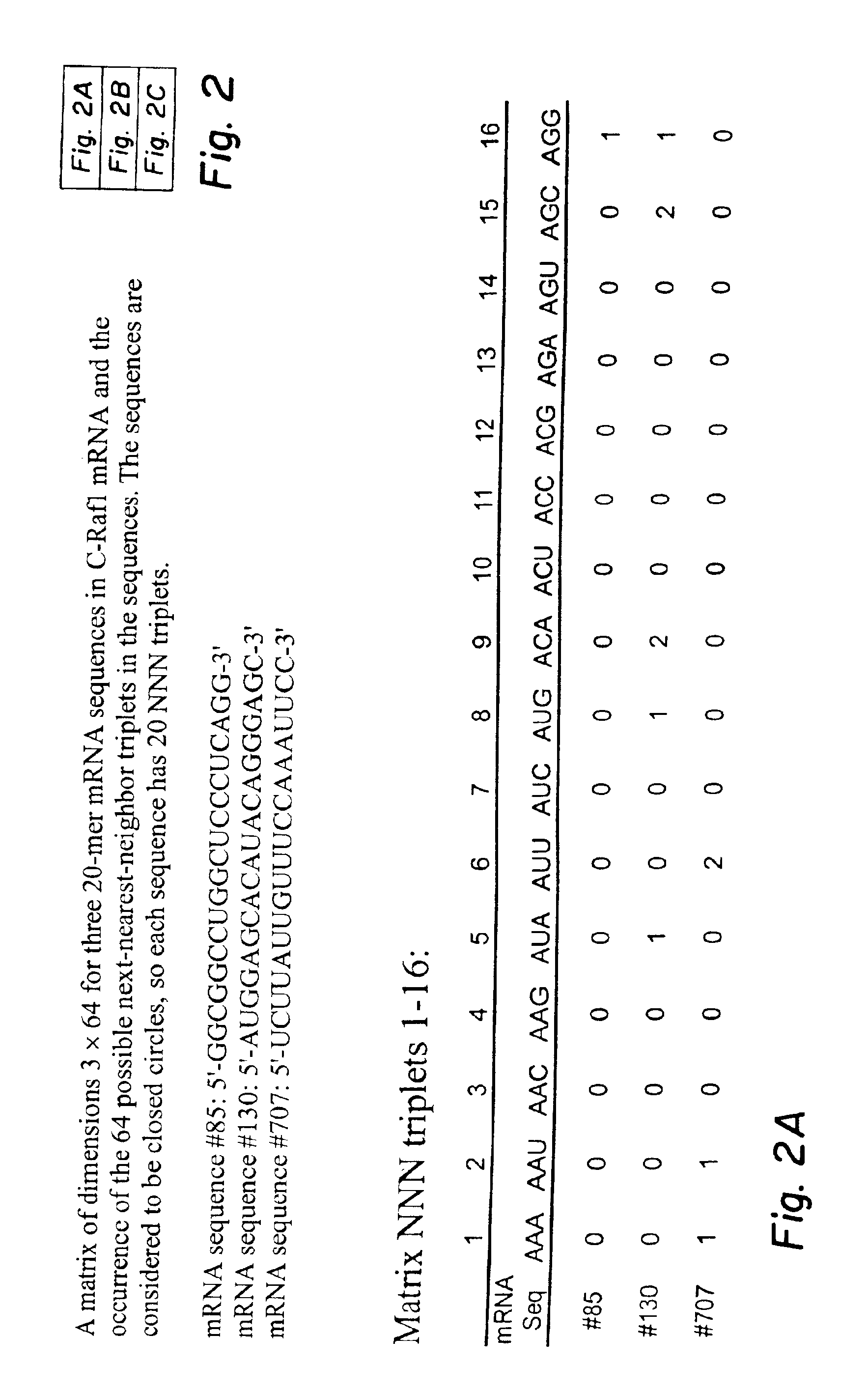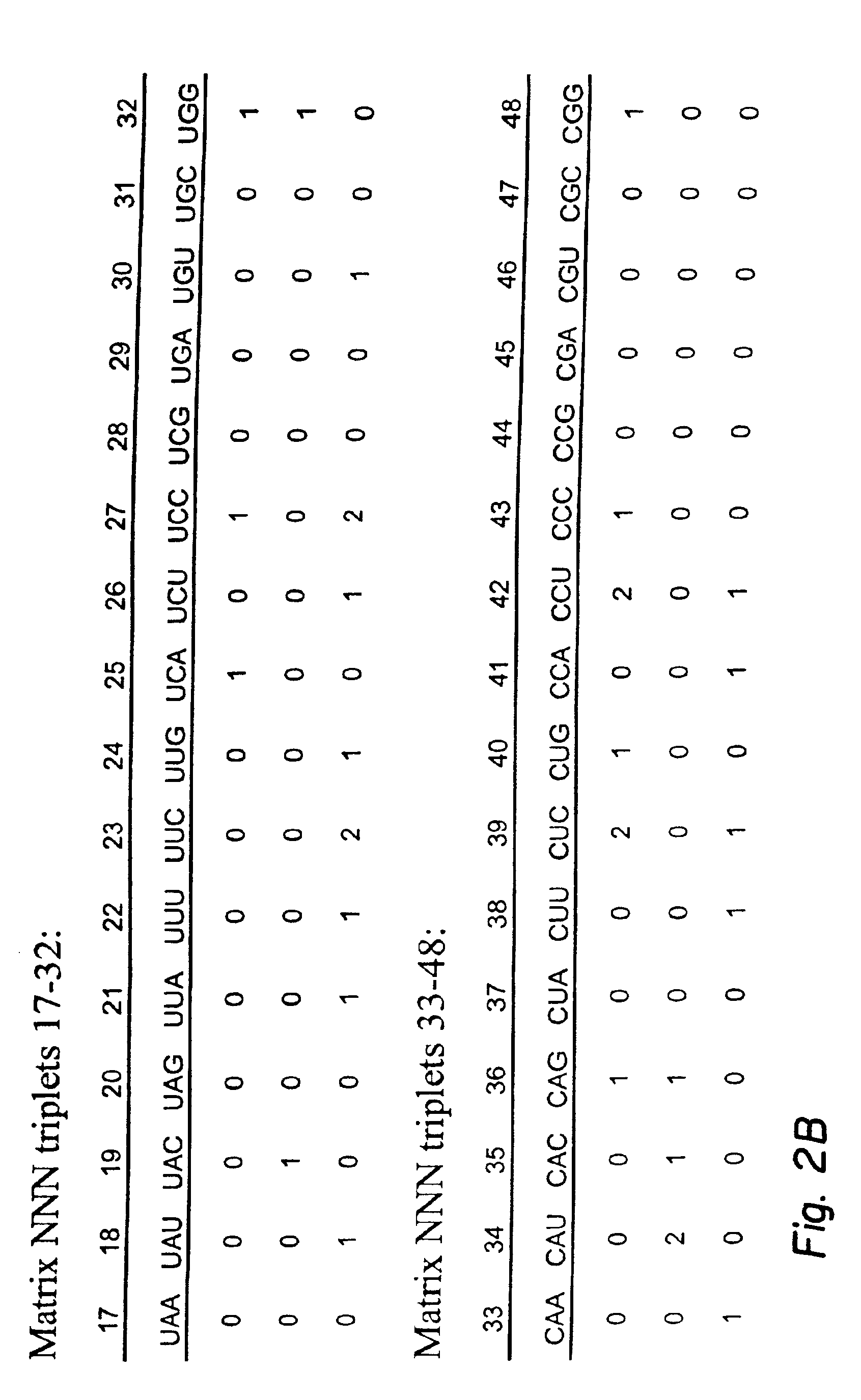Next-nearest-neighbor sequence determinants of antisense DNA
a dna and sequence determinant technology, applied in the field of antisense gene therapy, can solve the problems of inability to account for sequence-dependent in vivo effects, inability to predict with limited accuracy, and inability to predict with long sequences. data obtained under cellular conditions, data for longer sequences, etc., and achieves the effect of improving the accuracy of prediction
- Summary
- Abstract
- Description
- Claims
- Application Information
AI Technical Summary
Benefits of technology
Problems solved by technology
Method used
Image
Examples
working examples
Example A
[0038]FIG. 3A shows the fit of hybrid NN free energy values, ΔG°(37° C.), typical of NN stability predictions, to the measured inhibition values for the 102 antisense ODN sequences used to inhibit four gene products in two cell lines (data from Table 1). FIG. 3B shows the fit of the derived NNN values in Table 2, multiplied by the NNN triplets in each of the 102 ODN sequences, to the measured inhibition values. The fit to the NNN data set is better, as is shown by the correlation coefficients, r, and the significance values from the t-text, P, in the first row in Table 4. That is, the NN fit has a regression coefficient of 0.309, while the NNN fit gives a better regression coefficient of 0.778, and a lower value of P, although both fits are significant (below the P=0.05 level).
[0039]
TABLE 4Comparison of the regression coefficients, r, and the t-test Psignificance values from fits of various data sets with NN freeenergy values and with NNN parameters (Table 2).Fit with Neare...
example b
[0040]In this example, the predictions from the NNN parameters are compared with those from the NN free energy ΔG° for a data set that was not used in deriving the NNN parameters of Table 2. The data are published inhibition data from Western blots of PKCα protein taken after treatments with 20 antisense S-ODNs (Dean et al., 1994). As shown in FIGS. 4A and 4B, and in the second line of data in Table 4, the experimental inhibition data are better approximated by those of the in vivo NNN values than by the in vitro NN parameters. It is noteworthy that the NNN parameters give a fit that is significant (P=0.015), while the NN parameters give a fit that is not significant at the P=0.05 level (P=0.110).
example c
[0041]In this example, the predictions from the NNN parameters are compared with those from the NN free energy ΔG° for a second data set that was not used in deriving the NNN parameters of Table 2. The data are published inhibition data from Northern blots for two adhesion molecule mRNAs (E-Selectin and ICAM-1) taken after treatments with 33 antisense S-ODNs (Bennett et al., 1994). As shown in FIGS. 5A and 5B, and in the third line of data in Table 4, this experimental inhibition data is also better approximated by those of the in vivo NNN values than by the in vitro NN parameters. However, in neither case is the P value below the desired 0.05 value, indicating that additional factors remain to be identified by using a larger data set.
PUM
| Property | Measurement | Unit |
|---|---|---|
| Fraction | aaaaa | aaaaa |
| Fraction | aaaaa | aaaaa |
| Fraction | aaaaa | aaaaa |
Abstract
Description
Claims
Application Information
 Login to View More
Login to View More - R&D
- Intellectual Property
- Life Sciences
- Materials
- Tech Scout
- Unparalleled Data Quality
- Higher Quality Content
- 60% Fewer Hallucinations
Browse by: Latest US Patents, China's latest patents, Technical Efficacy Thesaurus, Application Domain, Technology Topic, Popular Technical Reports.
© 2025 PatSnap. All rights reserved.Legal|Privacy policy|Modern Slavery Act Transparency Statement|Sitemap|About US| Contact US: help@patsnap.com



